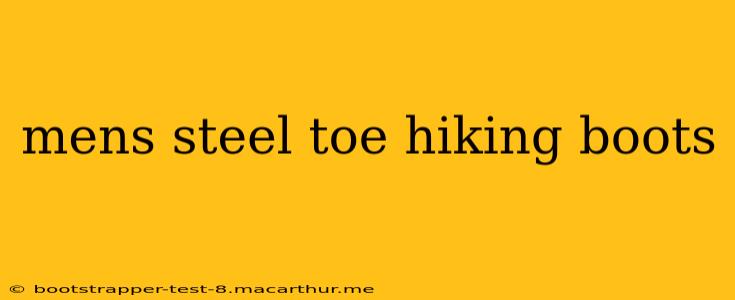Finding the right pair of men's steel toe hiking boots can be a challenge. You need footwear that provides the protection of steel toes for demanding work environments while offering the comfort, support, and traction necessary for navigating challenging trails. This comprehensive guide will help you navigate the world of steel-toe hiking boots, addressing common questions and concerns.
What are the Best Brands of Men's Steel Toe Hiking Boots?
Several reputable brands consistently produce high-quality men's steel toe hiking boots. The "best" brand depends heavily on individual needs and preferences, but some consistently well-regarded options include:
- Wolverine: Known for durability and comfort, Wolverine offers a range of steel-toe boots suitable for various terrains and work conditions.
- Timberland PRO: This brand focuses on work boots with a strong emphasis on safety and protection, often incorporating features desirable for hiking.
- Caterpillar (CAT): CAT boots are renowned for their rugged construction and ability to withstand harsh conditions. Their hiking-oriented steel toe boots often feature robust outsoles and supportive midsoles.
- Keen Utility: Keen is known for its innovative designs and focus on comfort and protection, frequently blending work boot features with hiking boot design elements.
- Danner: Danner produces high-quality, durable boots often favored by professionals who require both protection and performance. Their steel toe options are typically built to last.
This is not an exhaustive list, and many other excellent brands exist. Researching specific models within these brands will allow you to find the perfect fit for your needs.
Are Steel Toe Hiking Boots Heavy?
Yes, steel toe hiking boots are generally heavier than standard hiking boots. The steel toe cap adds significant weight, which can impact comfort and agility, particularly during extended hikes. However, advancements in materials and manufacturing have led to lighter steel toe boots than in the past. The weight will vary depending on the boot's construction and materials.
How Much Should I Spend on Men's Steel Toe Hiking Boots?
The price of men's steel toe hiking boots can vary considerably, ranging from under $100 to over $300. The price often reflects the boot's quality, materials, features, and brand reputation. While budget-friendly options exist, investing in a higher-quality pair often translates to better durability, comfort, and longevity, ultimately saving money in the long run. Consider your budget and intended use to determine the appropriate price point.
What are the Best Materials for Men's Steel Toe Hiking Boots?
The ideal materials for men's steel toe hiking boots depend on the specific conditions you'll face. However, some common and desirable materials include:
- Full-grain leather: Durable and water-resistant, full-grain leather offers excellent protection and longevity.
- Suede leather: Often more breathable than full-grain leather, suede is a good option for less harsh conditions.
- Nylon and other synthetic materials: These materials can provide lightweight durability and often boast excellent water resistance. They are frequently used in combination with leather for optimal performance.
How Do I Choose the Right Size for Steel Toe Hiking Boots?
Proper sizing is crucial for comfort and safety. It's recommended to try on steel toe hiking boots in person to ensure a proper fit. Consider wearing the socks you would typically wear while hiking when trying them on. Allow some room for your toes to wiggle, but avoid boots that feel too loose, as this can compromise safety and stability. Refer to the manufacturer's size chart for guidance, but always prioritize a comfortable in-store fitting if possible.
Remember, this is a general guide. Your specific needs will dictate the best choice for you. Always prioritize safety and comfort when selecting your men's steel toe hiking boots. Consider the terrain you'll be traversing, the climate, and the duration of your hikes when making your decision.
